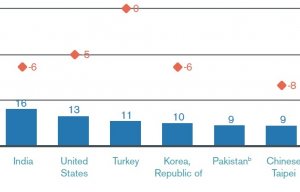
World textile and apparel exports fall in 2016
Opinion


Over 20 halls, Heimtextil 2016 is showcasing the products of a record 2,866 companies involved in global trade of textiles for home furnishings.
13th January 2016
Adrian Wilson
|
Frankfurt
The very first textile trade fair of the year kicked off at Messe Frankfurt in Germany on Tuesday (January 12th) on an extremely positive note.
Over 20 halls, Heimtextil 2016 is showcasing the products of a record 2,866 companies involved in the global trade of textiles for home furnishings – 143 more than were present at the 2015 event. They have descended on the city from no less than 69 countries, with 89% of companies from outside Germany. The biggest beneficiary of imports to Europe recently has been Pakistan, which due to a new free trade agreement, generated over €1 billion in additional sales in 2015. There are 221 exhibitors from the country present at Heimtextil 2016, but China remains the giant, with 525 exhibitors in attendance.
Germany’s own manufacturers of textiles for the home furnishings market though, are more than holding their ground in terms of added value, according to Martin Auerbach, director of the Association of the German Home Textiles Industry. He put the revenue generation of Germany’s overall textile industry in 2015 at €11 billion, with €3 billion accounted for by suppliers of fabrics for home furnishings – and over 40% being export trade. The key markets for these high quality German fabrics include contract fittings for hotel chains, cruise ships and planes.
Despite an extremely uncertain global economy, Auerbach added that the outlook for German home textile manufacturers on the domestic market was extremely positive.
“There is record employment and rising wages in Germany right now,” he said, “and meanwhile interest charges remain low, as do energy prices.”
Perhaps understandably, many German textile manufacturers are currently taking the opportunity to expand their capacities.
Doing equally well, is the show organiser Messe Frankfurt, which now has a cycle of no less than 49 global textile events, which at the most recent count attracted 19,000 exhibitors and 465,000 visitors from a total of 140 countries, according to the organisation’s board member Detlef Braun.
The theme of this year’s Heimtextil Theme Park is ‘Well-Being 4.0’, but in contrast to ‘Industry 4.0’, the concept is of creating a space away from the digital world – regardless of whether or not this is aided by unobtrusive technology.
Polyester specialist Trevira continues to dominate the market for contract furnishings with its CS brand, and at a press conference showcased a wide range of new fabrics that are being introduced by European manufacturers. These included materials with 3D effects, spacer fabrics and new digitally-printed creations.
As part of the Indorama Ventures group, Trevira reported a turnover of €250 million for 2015 and is now opening up its stringent branding system to textile manufacturers in Asia who are partnered with European CS brand holders. The company identified low-pill apparel fibres, PLA for technical applications, hybrid yarns with low-melt components and spun-dyed staple fibres – to replace yarn-dyed products – as key trends.
Meanwhile, post ITMA 2015, there is no escaping the rapid growth and further potential of digital printing, and the area displaying its technology and inks has been considerably expanded at Heimtextil. A one-day European Digital Textile Conference was held alongside the event on Tuesday, and I’ll file a separate report on it. The two key developments, however, are the so-called ‘single pass’ industrial machines, and the pros and cons of pigment inks – as opposed to those based on reactive or dispersed dyes – about which there is currently much lively debate, if not direct commercial rivalry.

Business intelligence for the fibre, textiles and apparel industries: technologies, innovations, markets, investments, trade policy, sourcing, strategy...
Find out more